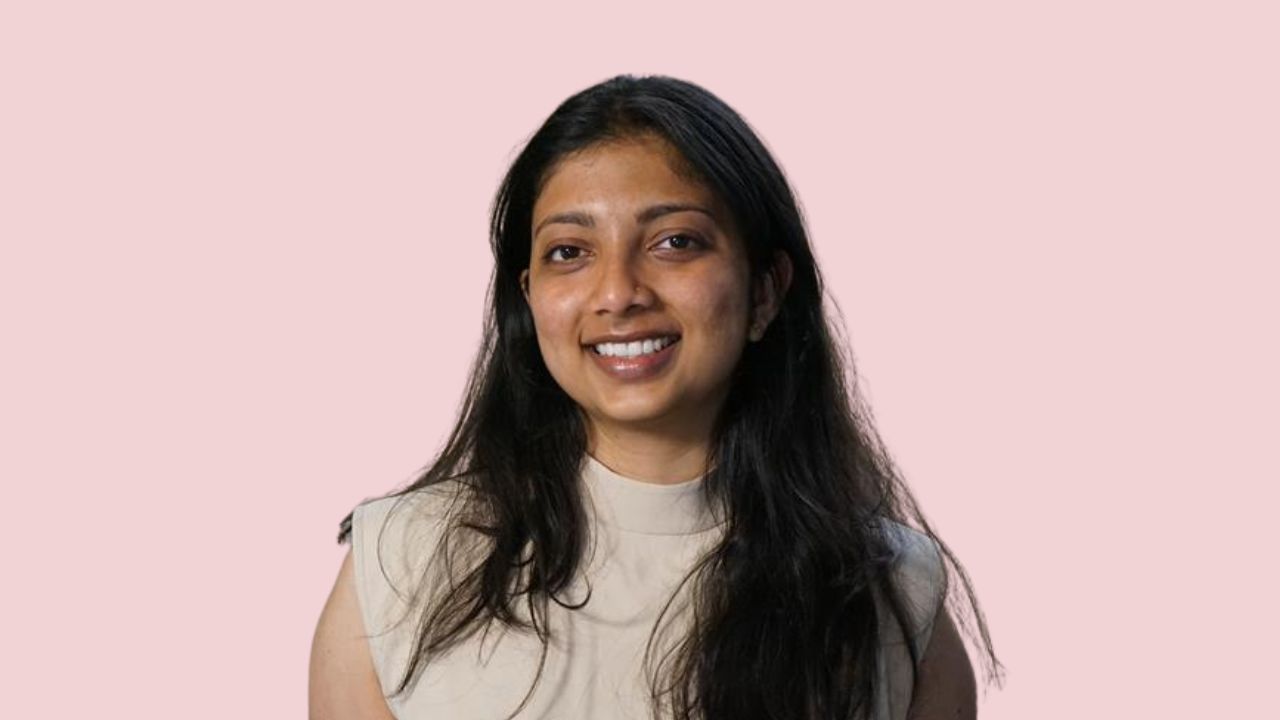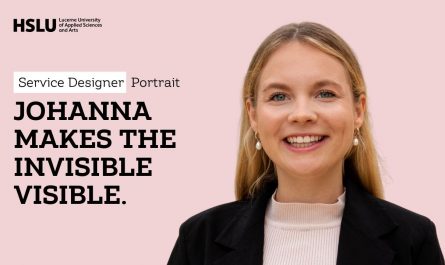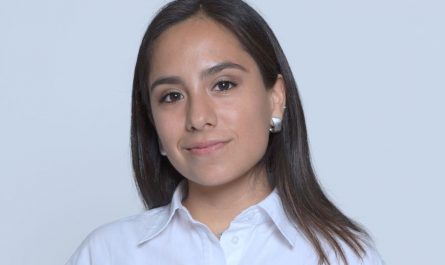In this interview Sharaya Naik shares her personal Service Design journey and why she is building bridges in the healthcare system in India. In this 15 minutes conversation Sharaya covers the following topics:
- Personal Portrait: Get to meet a Service Designer and her personal journey.
- Visualisation: See how a strong visual metaphor can make a complex topic easy to understand.
- Key skills: Discover what key skills and approaches can bring Service Design to the next level.
- Master: Discover if you too have the mindset to do a Master in Service Design.
Meet Sharaya in video
Connect with Sharaya Naik
Discover the Master Service Design program
- Program overview
- Ask a question to a student ambassador via a Whatsapp text message: +41 79 572 30 93
Interview highlights
Prefer reading than watching a video? Here some highlights from the interview that have been shortened and adapted for a smoother reading experience. You can find the full transcript of the interview at the bottom of this article.
How did you discover Service Design?
I did my bachelor’s in product design and in one of the semesters we were introduced to systems thinking. And that kind of opened thinking process beyond object design and more into ecosystems and systems thinking. Where we did a lot of zoom in, zoom out in different layers and how impacts, happen in a ripple effect in ecosystems which kind of interested me.
And later, when I was working as a UX designer, came across terms like, customer experience Service Design, which kind of led me into reading a lot of articles and books. And I also took up a summer course on Service Design which, of made me more sure of what Service Design is. And that’s how I decided to take it further for my masters and explore it.
What do you like about Service Design?
What I really like about Service Design is that it allows you to think beyond object design or just an interface design. it’s about orchestrating an experience looking into different touch points stakeholders and going deeper in the different processes and making the experiences better.
Service Design is a field that is not just related to experience, but also looks into the other aspects like business liabilities and other things as well. So. beyond what I used to do in product design and it kind of interested me.
What’s your Service Design project focus?
I am currently working on my master thesis where I explore how can we empower patients and informal caregivers like family members and loved ones, who are looking for support in navigating their rehabilitation journey. The project is focused in Indian context right now. These individuals who are undergoing through especially rare chronic conditions is what my project is focusing on.
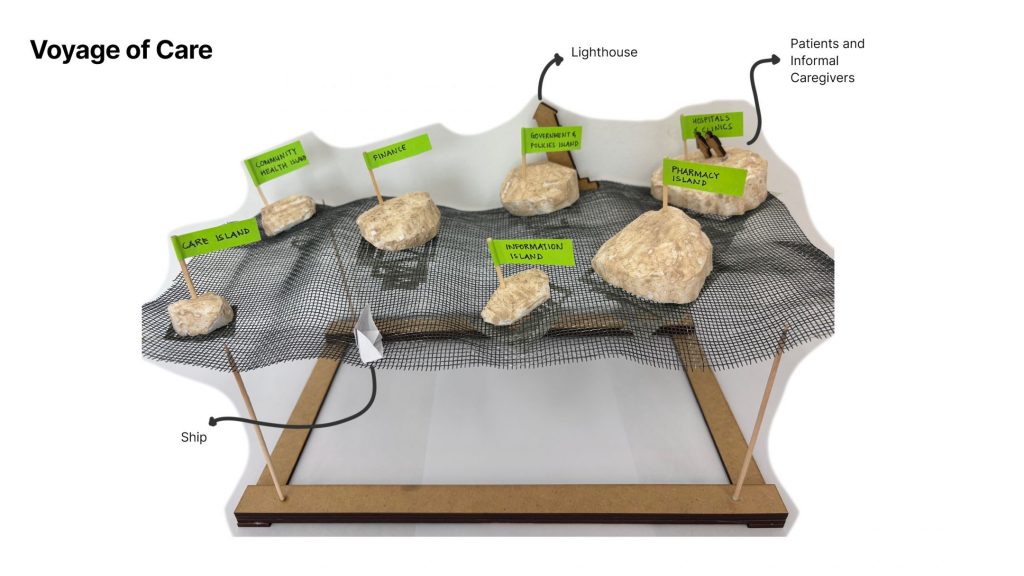
The sea journey where we can see the healthcare system in the form of ocean is the analogy that I always present whenever I’m talking about my project. Instead of calling it landscape of healthcare, I call it voyage of care.
It’s the sea journey where we can see the healthcare system in the form of ocean. And those islands are the different services that a patient and an informal caregiver generally touches.
When it is a rare, chronic condition, this particular landscape, the ocean of care is fragmented, where the parts of cares are not connected well. The structures are incomplete and which leads the patients and informal caregivers to navigate on these islands with a lot of back and forth.
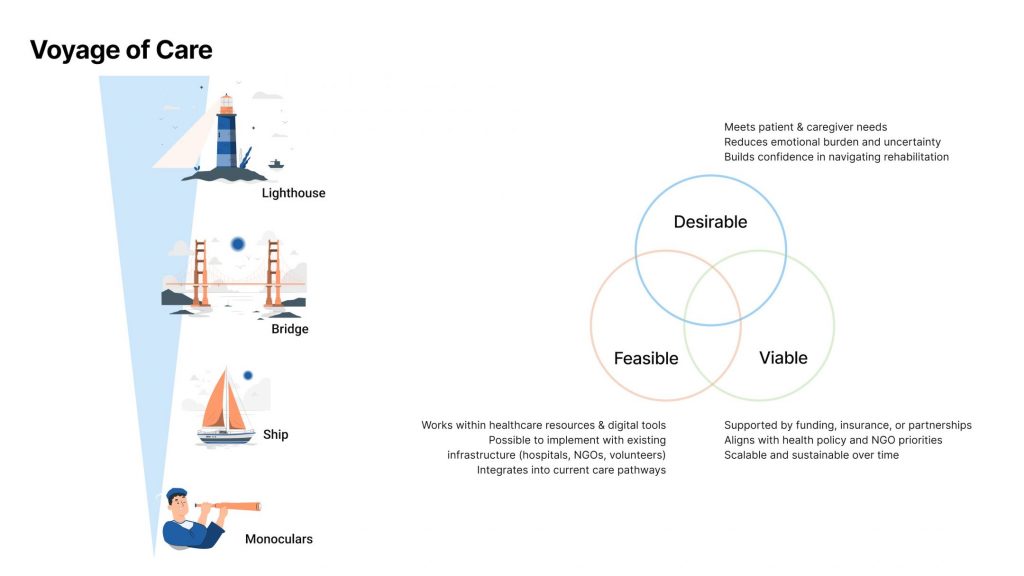
My project deals with researching what exactly do the patients and informal caregivers require? Do they require something like:
- a monocular, like a handheld tool? Whenever they need, they can use it;
- a ship, like a human assistance who can take them from an island to an end;
- a bridge that is well connected and improves their experience to go from an island to another island, and the lighthouse is like a government. Service or a scheme that navigates them.
What are key lessons you learned about Service Design?
Service Design actually broadened my thinking from a very object driven design thinking and, now when I look at the world, it’s completely different. Whenever I’m interacting with different services, I’m looking at them from a whole aspect of how they onboarded me or what worked, what didn’t work.
Something new that I learned is combination of business and strategy and knowing how to work iteratively while embracing ambiguities.
To whom do you recommend the Master in Service Design?
The Master Service Design program of the HSLU is for the people who are more curious about complexity, who are comfortable to work with ambiguity and patient enough to try and keep trying. Service Design is not just about people, but it’s also about services and processes. So this program is for somebody who’s also interested in going beyond user-centric processes and also keen on the systems and ecosystems part of it.
As a service designer I would say the most important thing that I learned at HSLU is collaborating with different stakeholders.
What can people do for you?
I would love to connect with people who are working in healthcare innovation research or chronic condition management. Whether you are a researcher, designer, or expert, I would really like to connect with you.
My broader ambition is to work in the healthcare field, in order to bring more visibility for the patients and caregivers in their journeys of rehabilitation.
Video transcript
This transcript was fully generated using Descript. The transcript wasn’t corrected. Which means it can be pretty creative, funny or wrong at moments.
Sharaya: What I really liked about Service Design is that it allows you to think beyond object design or just an interface design. It’s about orchestrating an experience looking into different touch points stakeholders and going deeper in the different processes and making it better.
Instead of calling it landscape of healthcare, I call it “voyage of care”. It’s the sea journey where we can see the healthcare system in the form of ocean. And those islands are the different services that a patient and an informal caregiver generally touches.
The structures are incomplete which leads the patients and informal caregivers to navigate on these islands with a lot of back and forth. Whenever I’m interacting with different services, I’m looking at them from a whole aspect of how they onboarded me or what worked, what didn’t work.
As a service designer I would say the most important thing that I learned was collaborating with different stakeholders.
It’s such a pleasure to be back again with Andy. Hi Andy, and today with Sharaya. So.
Daniele: And it’s such a pleasure because today we are introducing a new series where we do a bit of a portrait of Service Design learners within the Master Service Design of HSLU. And we are very excited to start this series with you, Sharaya today.
Sharaya: you so much for inviting me, Daniele and Andy.
Daniele: And let’s get started directly. Can you tell us a little bit more about you?
Sharaya: hi, I am Sharaya. I come from India. And I studied, design in my bachelor’s and currently I’m studying my master’s at HSLU in Service Design.
Daniele: Could you tell us a little bit how you discovered Service Design and why you chose to explore it further?
Sharaya: Okay. So as I said that I did my bachelor’s in product design and in one of the semesters we were introduced to systems thinking. And that kind of opened thinking process beyond object design and more into ecosystems and systems thinking. Where we did a lot of zoom in, zoom out in different layers and how impacts, happen in a ripple effect in ecosystems which kind of interested me.
And later, when I was working as a UX designer, came across terms like, customer experience Service Design, which kind of led me into reading a lot of articles and books. And I also took up a summer course on Service Design which, of made me more sure of what Service Design is. And that’s how I decided to take it further for my masters and explore it.
Daniele: What are the aspects of Service Design where you said, oh, this, this is pretty lovely.
Sharaya: What I really liked about Service Design or I still like about it, is that it allows you to think beyond object design or just an interface design. it’s about orchestrating an experience looking into different touch points stakeholders and going deeper in the different processes and making it better.
And it’s not just related to experience, but also looks into the other aspects like business liabilities and other things as well. So. beyond what I used to do in product design and it kind of interested me.
Andy Polaine: So I’m gonna ask you the question you’re probably dreading the most, which is, what project are you working on at the moment?
Sharaya: So I am currently working on my master thesis: how can we empower patients and informal caregivers like family members and loved ones, who are looking for support in navigating their rehabilitation journey. And it is focused in Indian context right now. These individuals who are undergoing through especially rare chronic conditions is what my project is focusing on. This is the analogy that I always present whenever I’m talking about my project. instead of calling it landscape of healthcare, I call it voyage of care. It’s the sea journey where we can see the healthcare system in the form of ocean. And those islands are the different services that a patient and an informal caregiver generally touches. When it is a common condition or a chronic condition like diabetes or hypertension, these islands are connected well, and there is a structure that really supports the patients and informal caregivers when they are diagnosed or, they are on the hospital and clinic island and they want to navigate. But when it is a rare, chronic condition, this particular landscape, the ocean of care is fragmented, where the parts of cares are not connected well. The structures are incomplete and which leads the patients and informal caregivers to navigate on these islands with a lot of back and forth. My project deals with researching what exactly do the patients and informal caregivers require? Do they require like a monocular, like a handheld tool? Whenever they need, they can use it. A ship, like a human assistance who can take them from an island to an end, A bridge that is well connected and improves their experience to go from an island to another island, and the lighthouse is like a government. Service or a scheme that navigates them. But while doing so, The project is also looking at, apart from the desirability of the patients and caregivers needs it would also be now looking at the feasibility and viability aspects like whether it’s feasible that it works. Within the existing systems, is it possible to be this service to be a part of the existing infrastructure and viable on the lines of, well, it can be scalable, sustainable, and whether it can be aligned to the existing health policies. So this is what I’m working on right now.
Andy Polaine: Amazing. I love good analogies and metaphors. I think they kind of help you understand complex topics and on that front, you are, attacking something very big. although you’re from India, it’s also kind of far away from where you’re currently sitting. So how are you managing to get that project into a sort of master size project?
Sharaya: Yes, that’s true. it’s a massive project, but looking at the limited time that I have, I am looking more at the initial interventions in this particular journey of patients and caregivers where I can quickly get in touch with the patients and a few experts and test out a few prototypes. While talking about the other interventions on the organizational levels are bit difficult at this timeline of Masters, but proposing them and making a structure of how that can happen or timeline so that I can take it forward even, after Masters is what my plan is.
Andy Polaine: Excellent. Well good luck with that. I know it’s a very big topic. I know it’s sort of one that’s so close to you too.
Sharaya: Yes.
Daniele: I’m sure that there are. Lessons that you’ve already learned through all the research, the different workshops that you did all the interviews what are maybe key lessons or insights about Service Design that you learned that changed your perspective on that field?
Sharaya: Service Design actually kind of broadened my thinking from a very object driven design thinking and, now when I look at the world, it’s completely different. Whenever I’m interacting with different services, I’m looking at them from a whole aspect of how they onboarded me or what worked, what didn’t work. But apart from it the key lessons that I would be taking with myself from the past one year that I’m studying would be yes, the systems thinking. Co-creation and human-centered thinking were something which I knew, but it got enforced. But apart from it, something that I learned new was business and strategy and also iteration and ambiguities is part of this process. So these would be my key insights or learnings that I did over the past one year.
Daniele: I hear two words. Which can feel for some people on different worlds business and ambiguity.
Sharaya: Well when I look at these two words, I know they are very apart from each other because business needs a strategy and needs a clear idea where, whereas ambiguity is you keep on testing and you keep on changing things in between. So, while business is more structured, so questions like relating it to my project, the questions like who funds the care coaches, the experts, or what partnerships can come in or go. And how can it be more scalable? These are the questions I would be looking at the business aspect, but the ambiguity of what thrives, what would be working in this process of service and what doesn’t, how are the reactions or the feedback loops and all would come in the ambiguity part of it where you exactly don’t know how things would work out.
Andy Polaine: I always say that spreadsheets are terrible vehicles for communicating human emotions. But at the same time, a service that doesn’t have a business model behind it is also never gonna be successful.
So you are coming into your second year of the masters, so you’ve had enough time to experience it and know a bit about it. Who do you think a Masters like this is for and who is it maybe not for?
Sharaya: Maybe I can answer this question on the lines of who for whom this master is for. it’s for the people who are more curious about complexity, I would say. and comfortable to work with ambiguity because sometimes you know how businesses work, but you really need to be patient enough to try and keep trying. And it’s not just about people, but it’s also about services and processes. So somebody who’s also interested in going beyond user-centric processes and also keen on the systems and ecosystems part of it. But. as a designer, irrespective of what designing you are doing, you would need to be more empathetic, thinker blend into the creativity. And as a service designer I would say the most important thing that I learned was collaborating with different stakeholders. I think it’s for the one who is curious about complexity, ambiguity, and somebody who is up for collaborating.
I would not really say who it is not for, but yes, these were the things that I saw were common between all of us.
Daniele: Extremely polite there. I really appreciated the kindness andin not sharing for who it isn’t. Maybe I’ll share a bit of a nasty one I think. it’s a masters, which pushes for autonomy a lot of the time. And I know that for people who come to the info days and tell me, you know, I like the structured I know exactly what happens when and I want to have the. Two year plan in advance, those types of people. I usually say that’s not the place where you will thrive because this is a place where you will learn how to work with ambiguity. And gonna be a bit hard. It’s quite something beautiful, but if you are not ready to explore that ambiguity, then it can be something that is quite frustrating.
From all this experience that you had, it’s nearly already two yearsDo you have a. lovely memory of something that happened during the program that you think you will keep in memory for the next years.
And thinking back, you know, that was kind of something that was a nice moment, a learning moment or just a deep bonding moment that you’ll keep with you as a memory.
Sharaya: Well the first thing that strike my mind was our informal connects, or I would say like the lunches or our things that happened bonded us well. We were sharing our different experiences and cultural backgrounds which kind of made me learn so much about Switzerland. So that was the first thing that came to my mind was, apart from the courses and classes that we had, these moments were something that really nice.
Daniele: so you’re doing this project, which is a beautiful project in India about healthcare. How can people support your work.
What can people do for you?
Sharaya: So I would love to connect with people who are working in healthcare innovation research or chronic condition management. And, whether it’s researchers, designers, or experts, I would really like to connect with them. This is something that is my broader ambition to work in the healthcare field, bring more visibility for the patients and caregivers in their journeys of rehabilitation.
I’m open for many more projects in and around healthcare. I would like to connect with the people who are happy to exchange ideas, collaborate or even share their experiences and perspectives around it.
Andy Polaine: Wonderful. I hope lots of people get in touch.
Daniele: I’m very curious around. will happen next? Obviously, you still have a bit of time to finish your master’s but where do you see your world tour continuing? So you came from India to Switzerland. Will you continue your journey in Switzerland and somewhere else? Tell us a little bit about how that journey will continue.
Sharaya: I would really like to continue my journey and learn more. With regards to this project or healthcarein general. the land is known for its healthcare and hospital, services.
And I would like to deep dive and explore practice and get to know more about the industry in future.
Daniele: Thank you so much, Sharaya. It’s been really a pleasure to have you first for this series because I think it’s a beautiful project that has very interesting potential impact on lives of many people.
So that’s a beautiful thing. I just wanted to say a big thank you to you and for those who are listening to you and who say. this journey of Sharaya sounds interesting. on the website of the HSLU you can find more information, but more importantly, you can ask to be connected to someone from the program that can answer all your questions.
But for now a big thank you to you Sharaya. A big thank you to you, Andy. It’s been a pleasure. And have a lovely rest of the summer.
Sharaya: Thank you so much for inviting. Thank you.
 by
by 